ANTONIO RASPA, EUROPEAN PHOTONICS INDUSTRY CONSORTIUM (EPIC)
The use of lasers for art conservation was pioneered by American research physicist John Asmus, who, in 1972, first leveraged lasers to clean marble sculptures in Venice without harming the underlying works. Over the next 30 years, Asmus further introduced the use of holography, ultrasonic imaging,
digital image processing, and nuclear magnetic resonance to art conservation
practices. Applying these tools to the problems of divestment, analysis, interpretation, and presentation, Asmus worked on art conservation projects involving the world’s most famous cultural objects, including recapturing the original vitality of the “Mona Lisa” and restoring the Qin dynasty terra-cotta army in Xi’an, China.
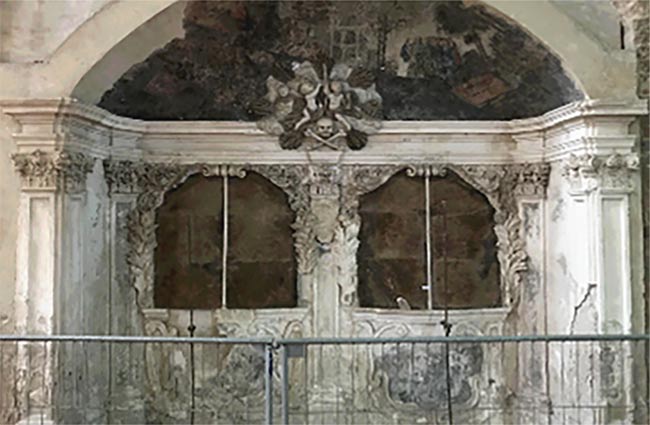
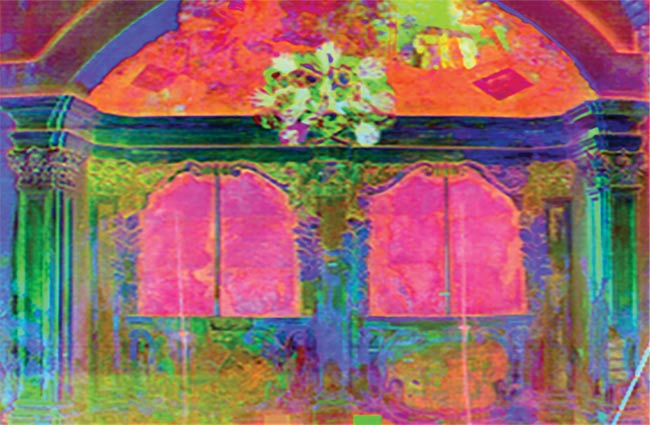
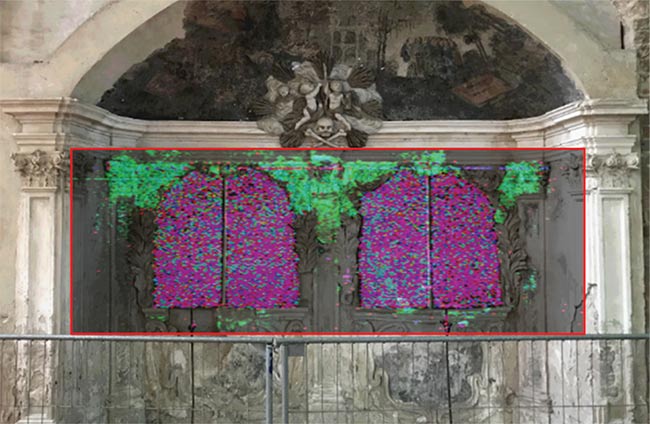
Figure 1. A conventional image of a Baroque hereditary burial site located at St. Mary’s Church in Frankfurt an der Oder, Germany (top). In the false color representation of the principal component analysis (PCA), the results show the high spectral variance of the stucco ornaments (middle). The calcite distribution map displays an absorption feature at about 2320 to 2340 nm (bottom). The carbonate absorption feature was calculated over a larger spectral range because lime stucco may contain gypsum, aggregates, or other binders, in addition to carbonate components, which can all cause a shift in absorption feature position. Courtesy of Norsk Elektro Optikk AS.
Over the last decade, new photonic
instruments and techniques have emerged that allow cultural heritage experts to leverage the entire electromagnetic spectrum for insights. Combined with advanced data and image processing technology to meet the challenges of big data analytics, these new tools are enabling examination of whole objects and entire collections. Together, multimodal imaging, multitechnique integrated analysis, and data fusion are heralding a new generation of optical applications for cultural heritage preservation.
Hyperspectral imaging
Hyperspectral imaging is a novel analytical technique based on spectroscopy that measures the optical wavelengths coming from each point of a scene with fine spectral resolution. The resulting hyperspectral image contains an extensive amount of information, and many numerical methods and algorithms have been developed to extract quantitative parameters related to the physicochemical properties of the imaged objects, and to enable the clustering of these properties into various components for analysis.
These capabilities make hyperspectral imaging well suited to assist in a variety of cultural heritage preservation activities. For the preservation of monuments, for example, it offers a nondestructive way to examine the composition of surface materials to map the distribution and concentration of foreign materials left by previous restoration efforts.
High-resolution hyperspectral imagers from Norwegian company Norsk Elektro Optikk AS, which capture images in the 400- to 2500-nm range, identified the previously used restoration materials, as well as performed damage analysis at a Baroque hereditary burial site in Frankfurt an der Oder, Germany. The use of hyperspectral imaging helped to qualify past restoration measures and evaluate
the overall state of the monument. As Figure 1 illustrates, the spectral differences of the monument’s lime stucco features highlight the compositional change in the supplemented vine ornaments (above the inscription panels, shown in the bottom image), which deviate from the original stucco version.
Hyperspectral imaging has also been applied to the conservation and analysis of paintings. Such applications have been implemented using cameras from the Italian company NIREOS srl (Figure 2), which leverage a patented Fourier transform technique that provides exceptional light throughput and high-quality data even at very low light levels. This capability makes NIREOS’ hyperspectral cameras particularly useful in cultural heritage studies, where low-illuminance conditions are recommended to avoid damaging samples. Furthermore, the cameras combine high spatial and spectral resolutions with an easy point-and-shoot approach. In cultural heritage applications, the NIREOS technology has already been used to date paintings, monitor their states of conservation, and assess their authenticity.
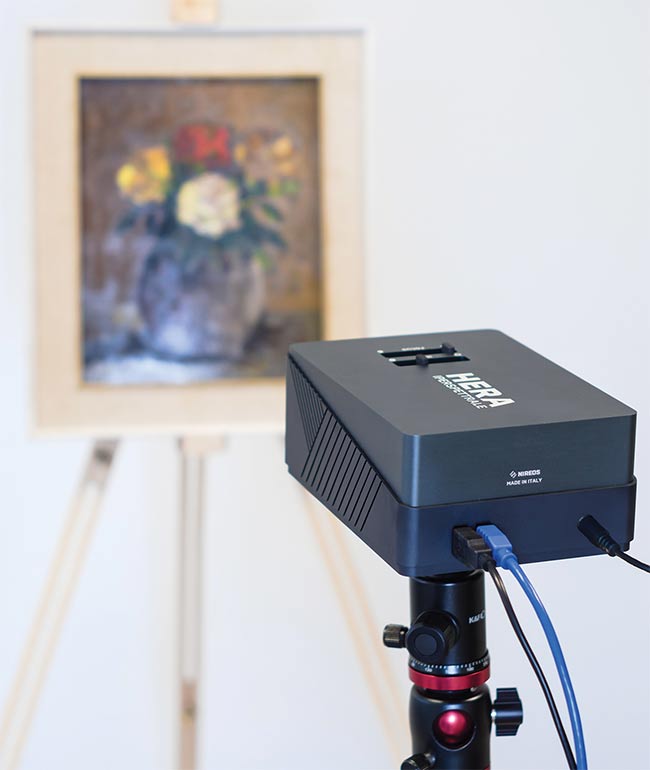
Figure 2. Hyperspectral cameras capture, with fine spectral resolution, a two-dimensional map of the optical wavelengths reflected from an object. The resulting spectral data cube contains an extensive amount of information that can provide insights into the physicochemical properties of the imaged objects and map these properties into a framework for analysis. The technology often helps validate the authenticity of artworks, reveal when they were produced, and evaluate the state of their conservation. Courtesy of NIREOS.
Spectroscopic techniques
As a long-established fixture in the art conservation toolbox, spectroscopy
techniques ranging from Raman and laser-induced fluorescence to x-ray fluorescence continue to see broader adoption in the field as advancements in the technology emerge. These advancements include new generations of mobile analytical tools designed for optical and spectroscopic investigations of immovable cultural heritage surfaces. They also encompass instruments that are able to combine 3D models, 2D images, and point data information on composition and stratigraphy.
The Italian National Agency for New Technologies, Energy and Sustainable Economic Development (ENEA) is a pioneer in the use of these tools for art conservation (Figure 3). The organization developed its own laser scanner prototypes that it used in 2020 to characterize the surface morphology and composition of a well-known Etruscan tomb from the fifth century BCE.
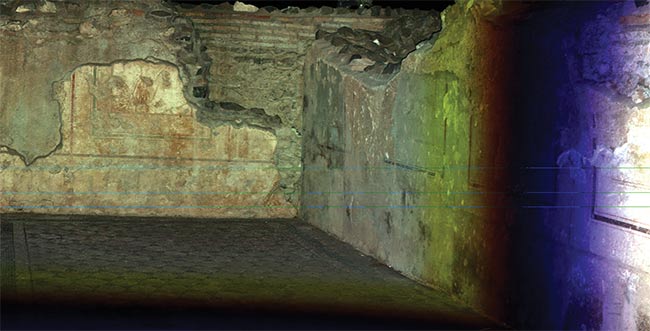
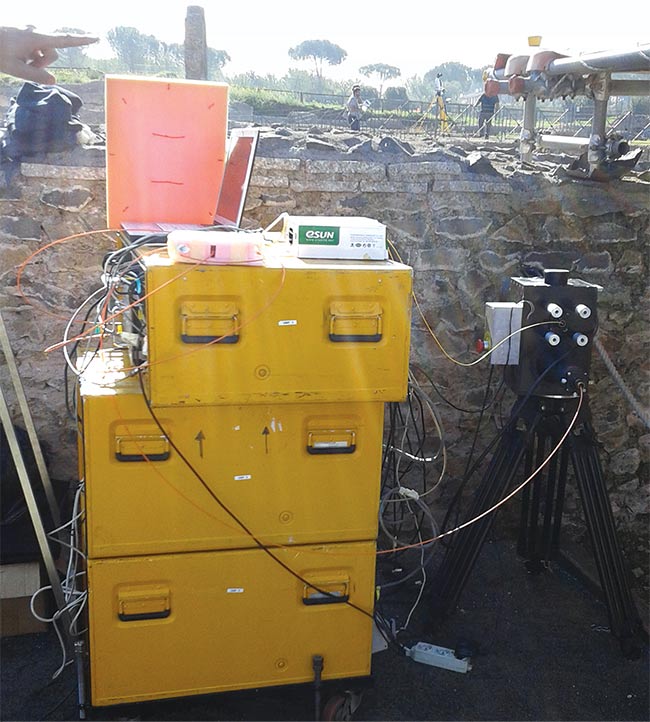
Figure 3. A photogrammetric 3D model of a public space from the imperial period in the ancient Latin city of Gabbii on the outskirts of Rome. The model shows high-resolution detail of the mosaic floor (top), collected using a prototype of a red, green, blue imaging topological radar (RGB-ITR) laser scanner (bottom) developed by the Italian National Agency for New Technologies, Energy and Sustainable Economic Development (ENEA). Courtesy of ENEA.
More specifically, ENEA used both Raman and laser-induced fluorescence spectroscopy to investigate the surface composition of the tomb, while the agency used x-ray fluorescence techniques to explore the surface’s atomic composition. These studies provided comprehensive information on the iron-based earth and the copper-based blue pigments used in the tomb, which further confirmed the first use in Italy of the synthetic pigment cuprorivaite, known as Egyptian blue. Furthermore, the creation of a high-resolution 3D model allowed all of the complementary information gathered by the different in situ techniques to be linked together and placed in a digital archive for easy, web-based access.
Photoluminescence imaging
Spectral time-gated photoluminescence imaging is another
technique for analyzing the spectral and temporal features of optical emissions gathered from paintings. The technology can detect and differentiate luminescent pigments based on the wavelengths of their emission spectra, as well as the lifetime of their photoluminescent signals. This type of UV-fluorescence photography is used routinely at ArtIS (the Imaging and
Spectroscopy laboratory for Art and Cultural Heritage at the Polytechnic University of Milan), which developed an analytical setup that relies on a nanosecond-pulsed Q-switched UV laser source operating at 355 nm. The laser excites optical emissions from an area of interest on the surface of an artwork. These emissions are then collected by a time-gated intensified camera equipped with optical filters to achieve the desired spectral resolution.
As shown in Figure 4, the technique helped art conservators to analyze the types of paint and pigments used in the creation of the 1928 oil painting “Anna a tavola” by Giovanni (Gianni) Maimeri. Besides the mere qualitative observations that the optical emission from a painting provides, the analysis of both spectral and temporal features can also reveal useful information about the pictorial materials employed by an artist, such as
zinc white (ZnO) and cadmium yellow (ZnCdS) paints. This in-depth knowledge of artist materials plays a crucial role in the fine-tuning of restoration and conservation protocols, as well as in the dating and understanding of ongoing degradation phenomena.
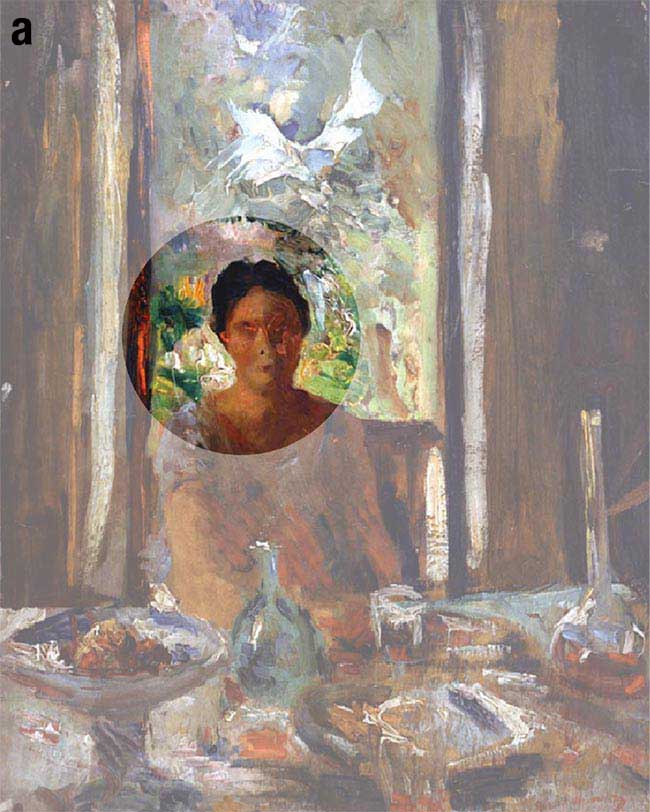
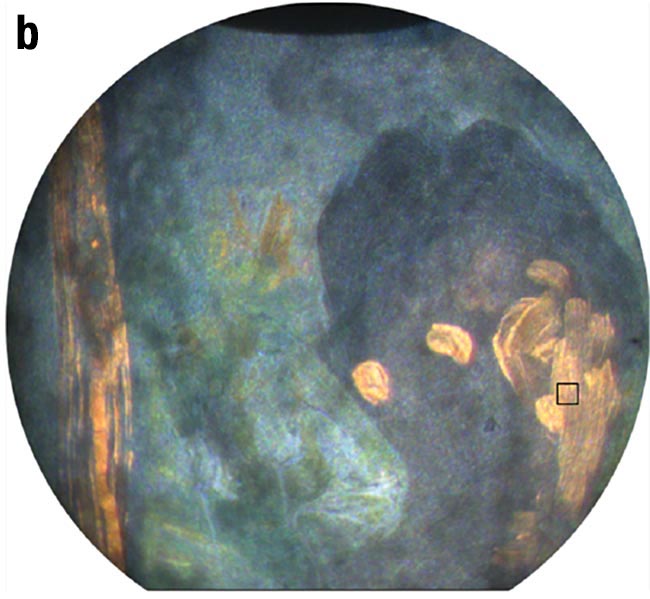
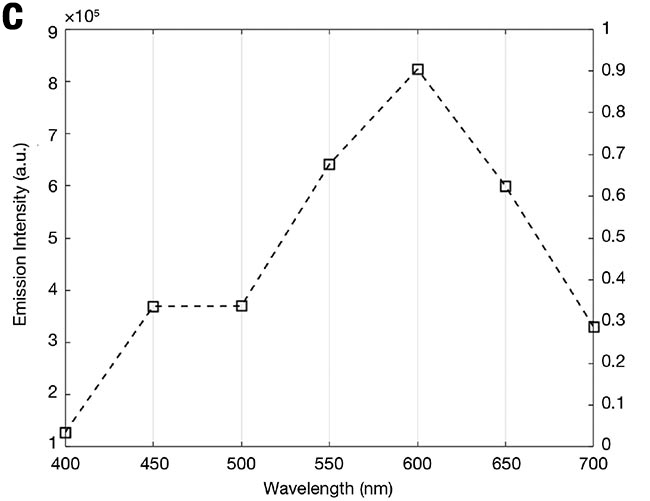
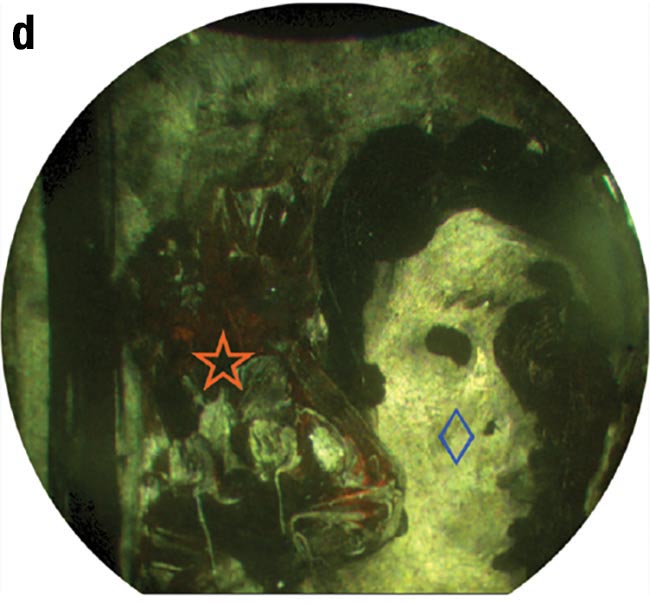
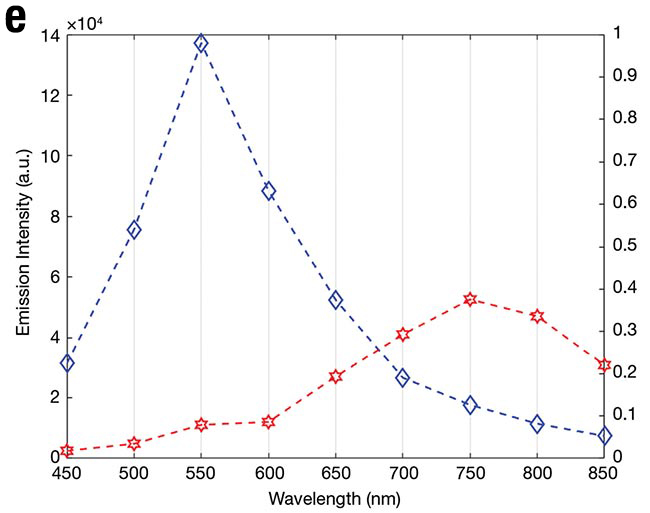
Figure 4. Art conservators utilized spectral time-gated photoluminescence imaging to investigate the types of paint and pigments used in the creation of the 1928 oil painting ‘Anna a tavola’ by Giovanni (Gianni) Maimeri. By focusing on the face of the woman depicted in the painting (a), it is possible to observe that, at nanosecond timescales, an orangish photoluminescent emission occurs on the left side of the face and on the window jamb (b). The mean time-gated spectrum reconstructed in the orangish-emitting regions displays a broad emission peak at 600 nm (c), which indicates the use of an organic synthetic colorant or a red lake-based paint. Spectral imaging of emissions lasting over microseconds reveals the presence of other artist pigments. Namely, it reveals an intense emission on the right side of the face (d) peaking at 550 nm, and a near-infrared emission broadly distributed between 700 and 850 nm (e) corresponding to the yellow/orange areas on the figure background. These spectral features were ascribed to trap state emissions in zinc white (ZnO) and cadmium yellow (ZnCdS) paints, respectively. Courtesy of Politecnico di Milano.
AR/VR technologies for cultural tourism
All of these photonics-based analytical tools, and others, are providing new and efficient approaches for evaluating and conserving works of art and antiquities, while also providing nondestructive methods with which to collect an unprecedented amount of data.
Yet, as optical technologies promise to expand our understanding and preservation of cultural heritage, such technologies are also introducing opportunities for these works to be appreciated more broadly and in innovative experiences.
Photonics-enabled augmented and virtual reality (AR/VR) technologies offer a way to enrich tourists’ experiences at archaeological sites and monuments. In 2020, for example, the European Space Agency launched VADUS (Virtual Access and Digitalization for Unreachable Sites), a project demonstration aimed at leveraging AR/VR technologies in combination with 5G networks and satellite link technology to introduce new services to tourists who wish to explore cultural heritage items and sites. The goal is to use data from the various diagnostic tools outlined above to create reliable 3D models of antiquities and locations.
As photonics technologies have helped bring portable
analytical tools directly to the sites of antiquities to provide deeper insights, so shall AR/VR-driven programs such as
VADUS allow tourists to experience remote and unreachable archaeological sites, monuments, and museums virtually,
while augmenting their experiences of these treasures.